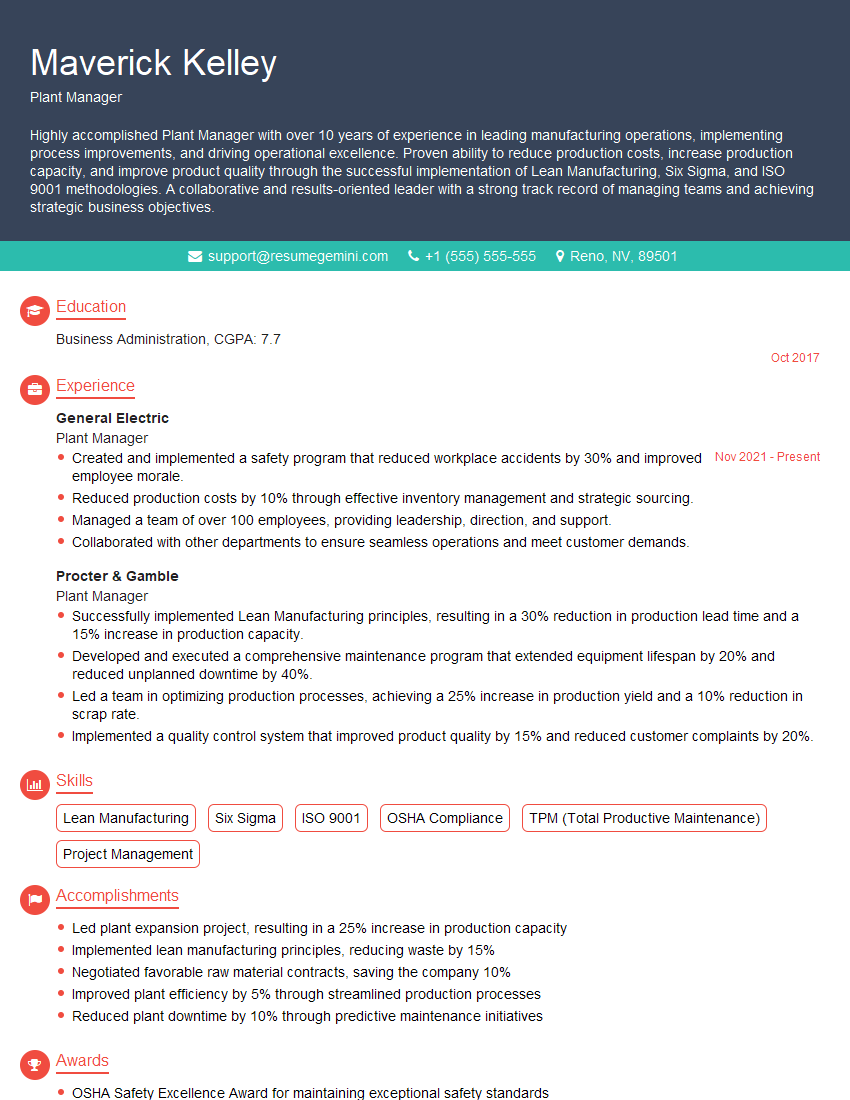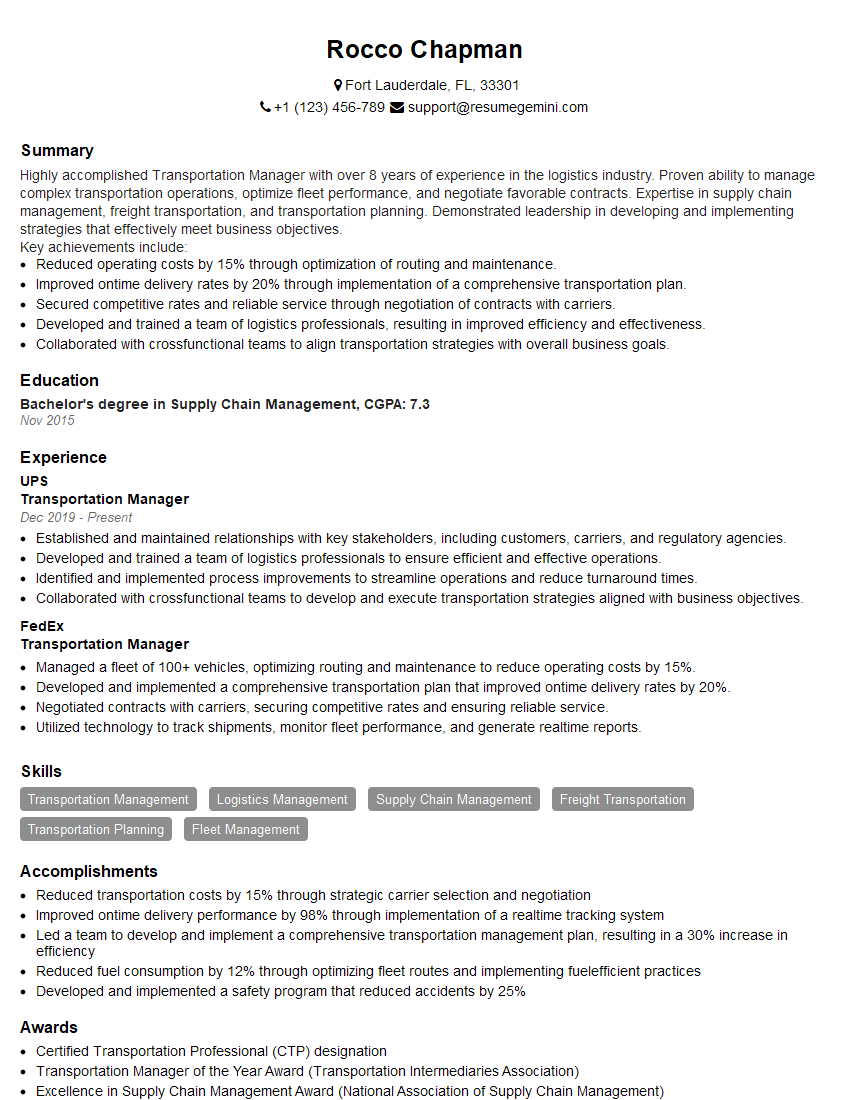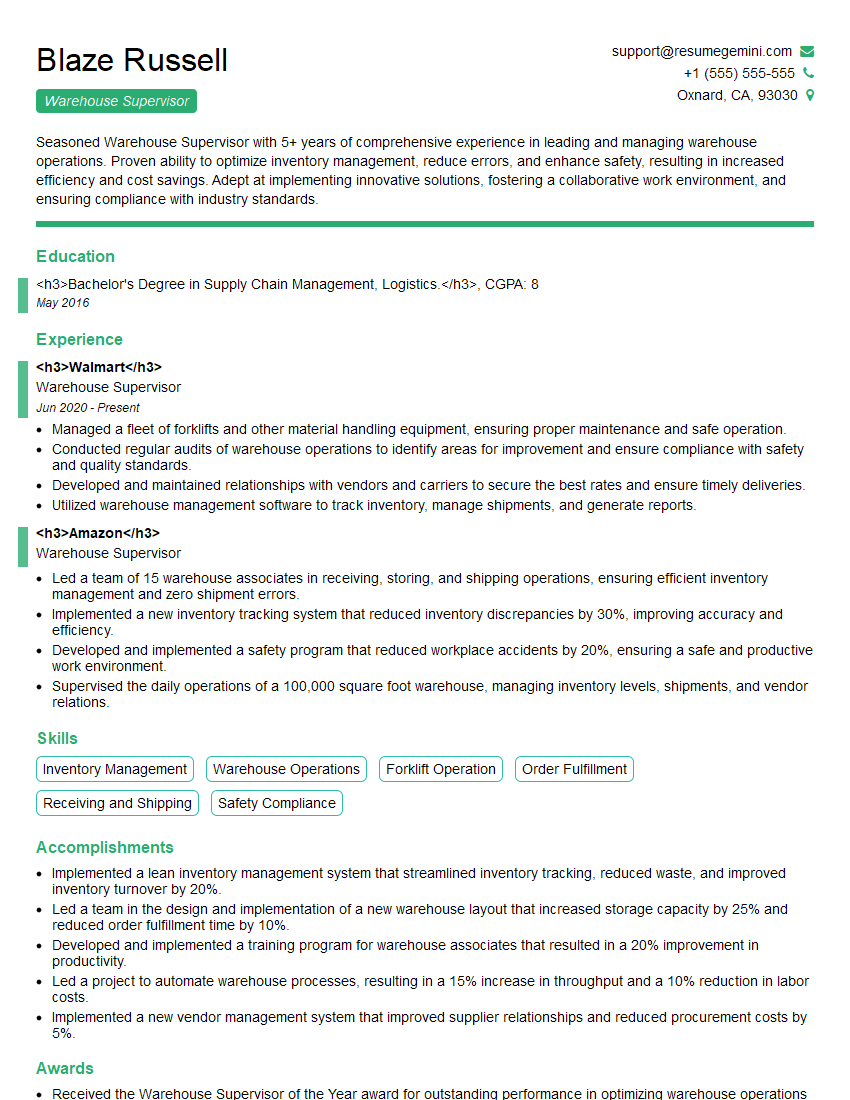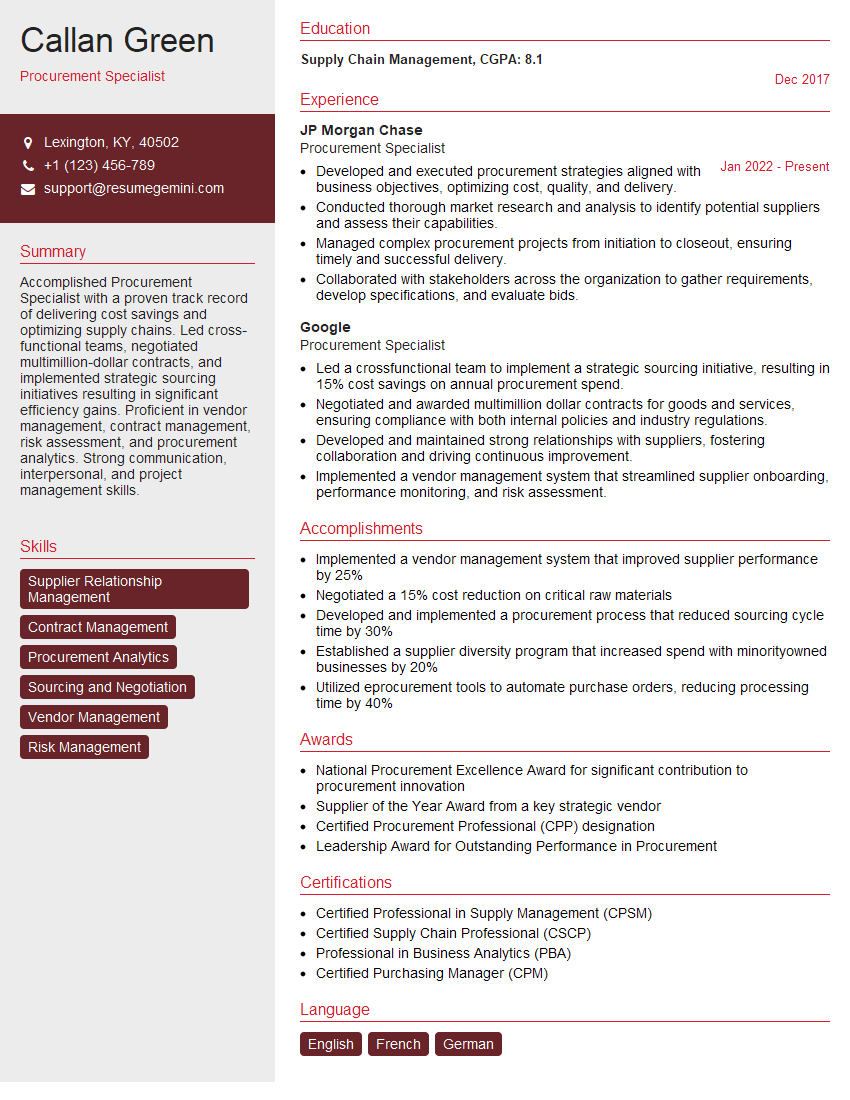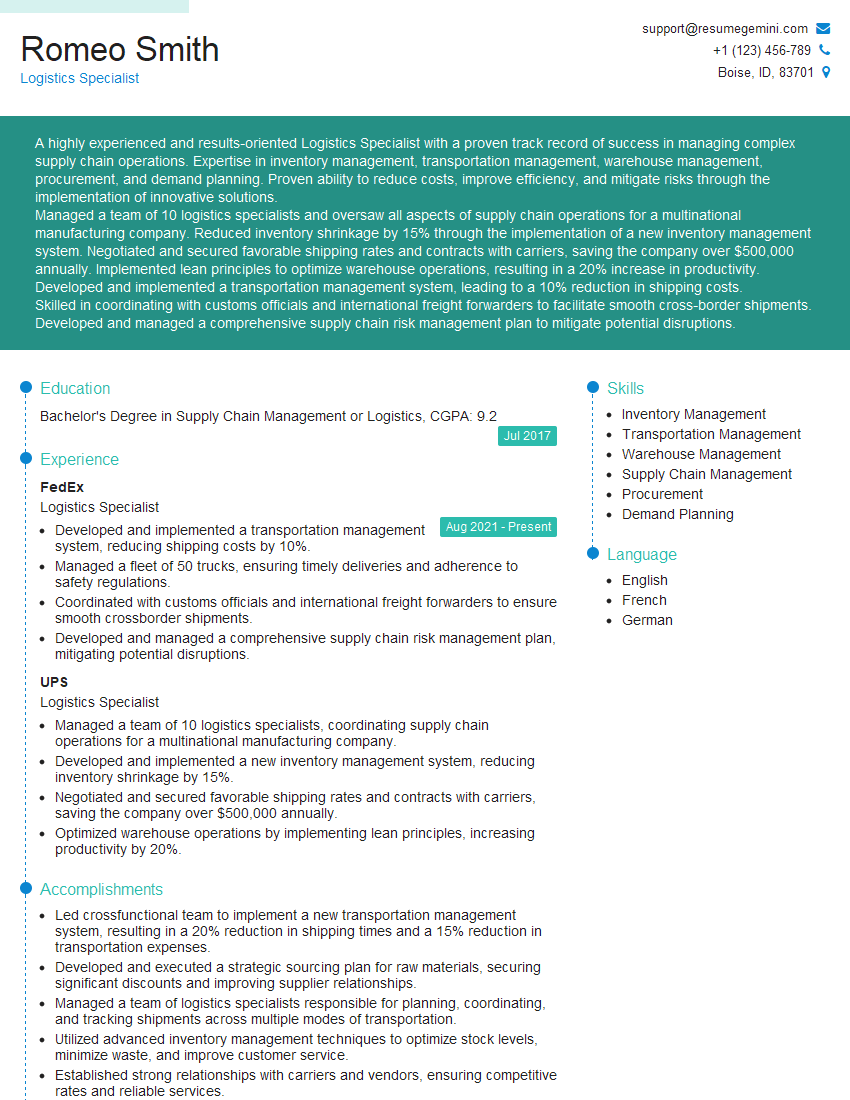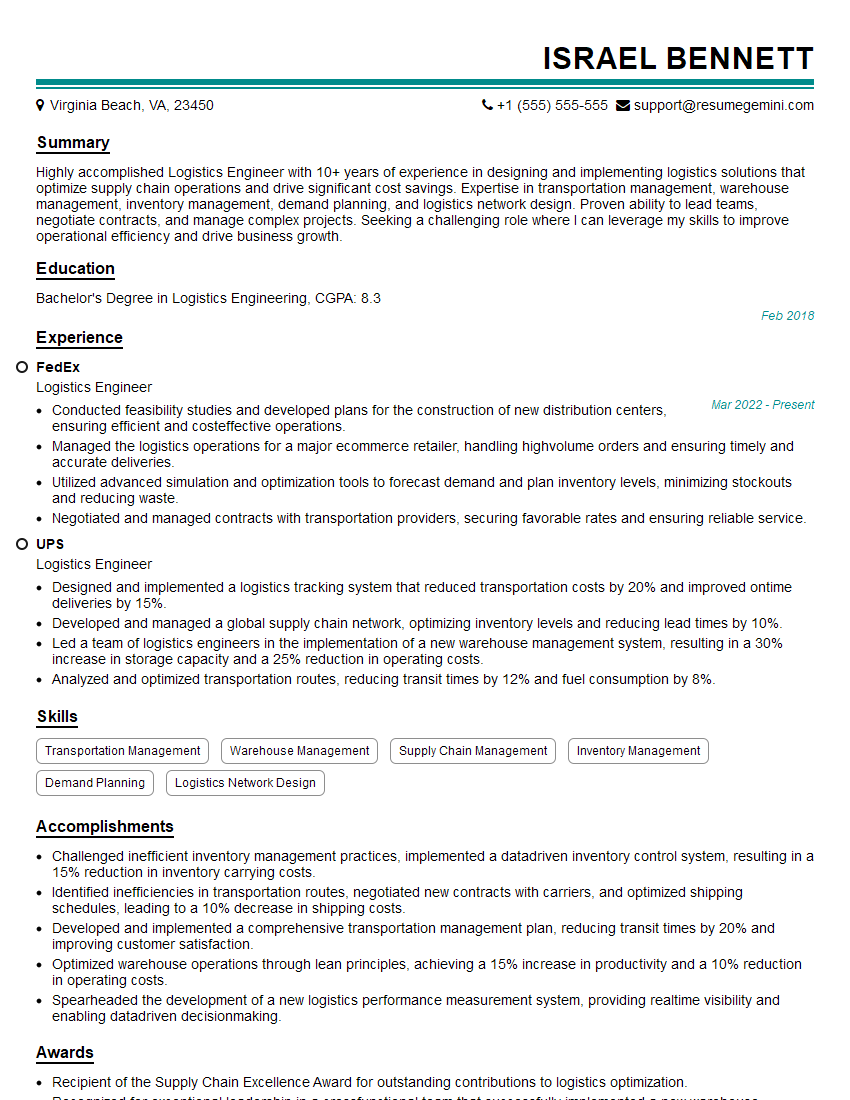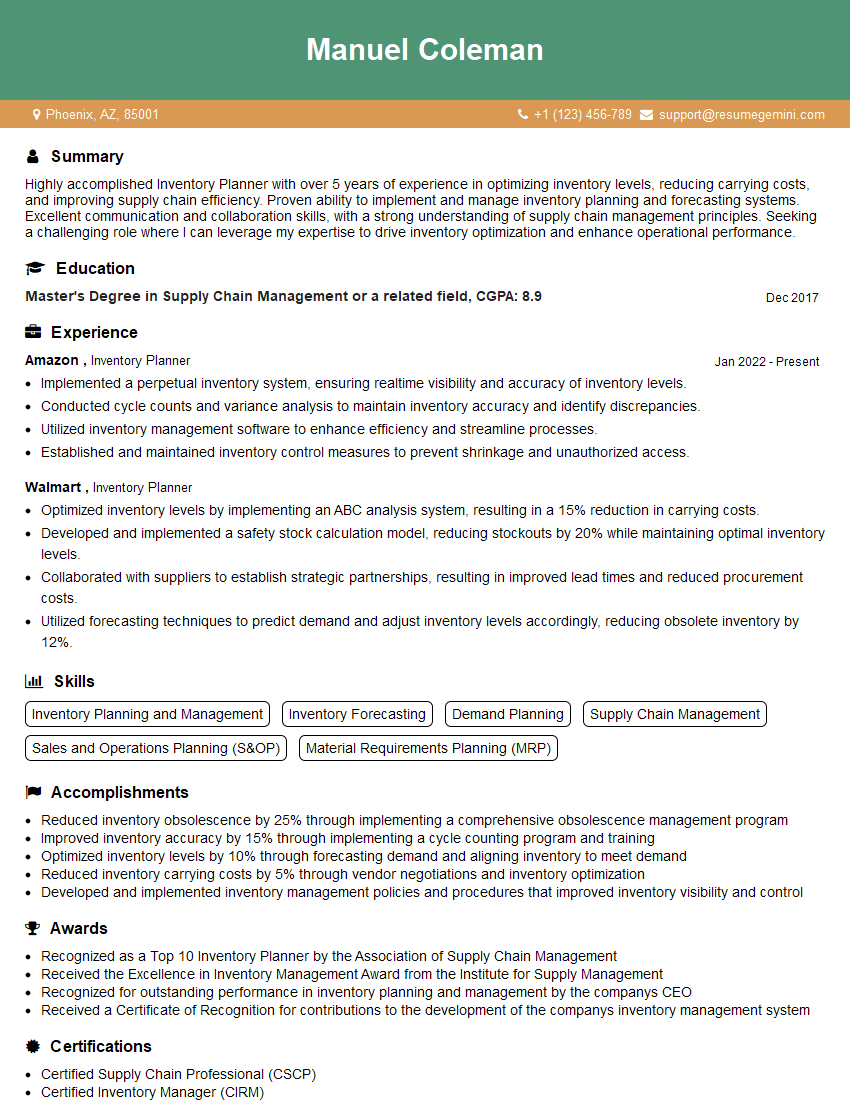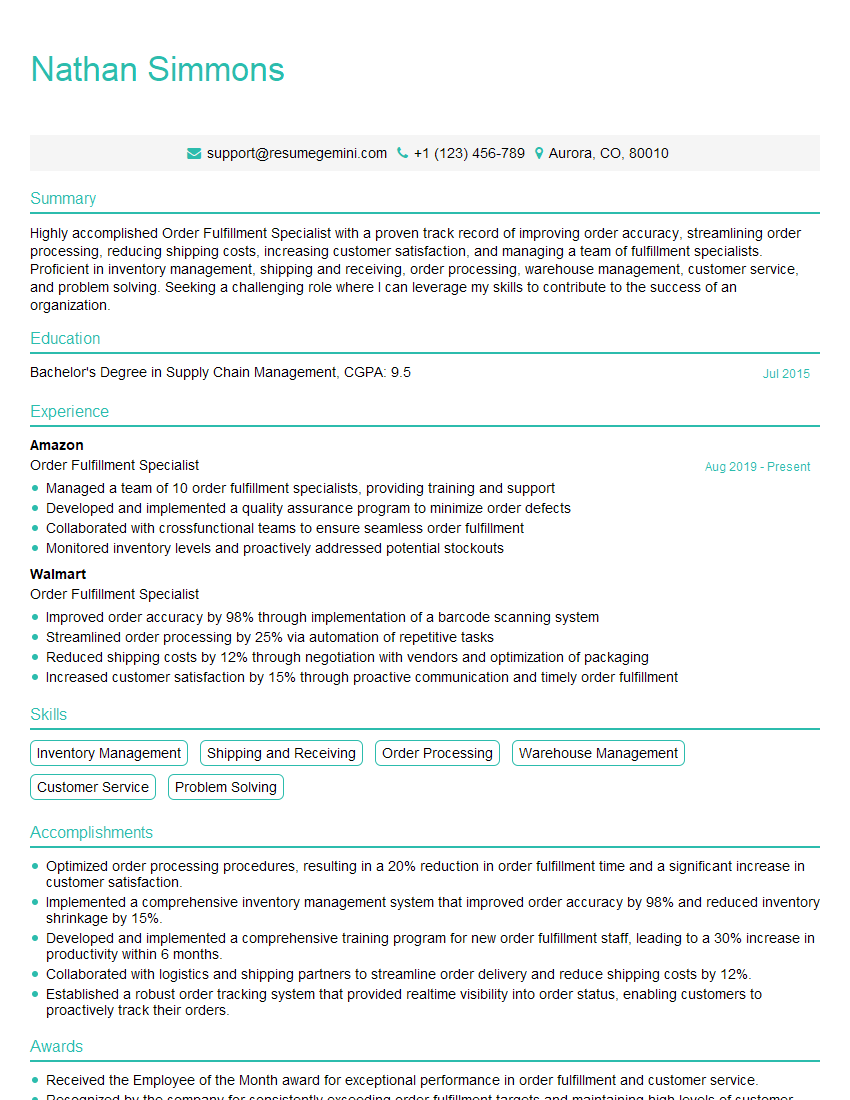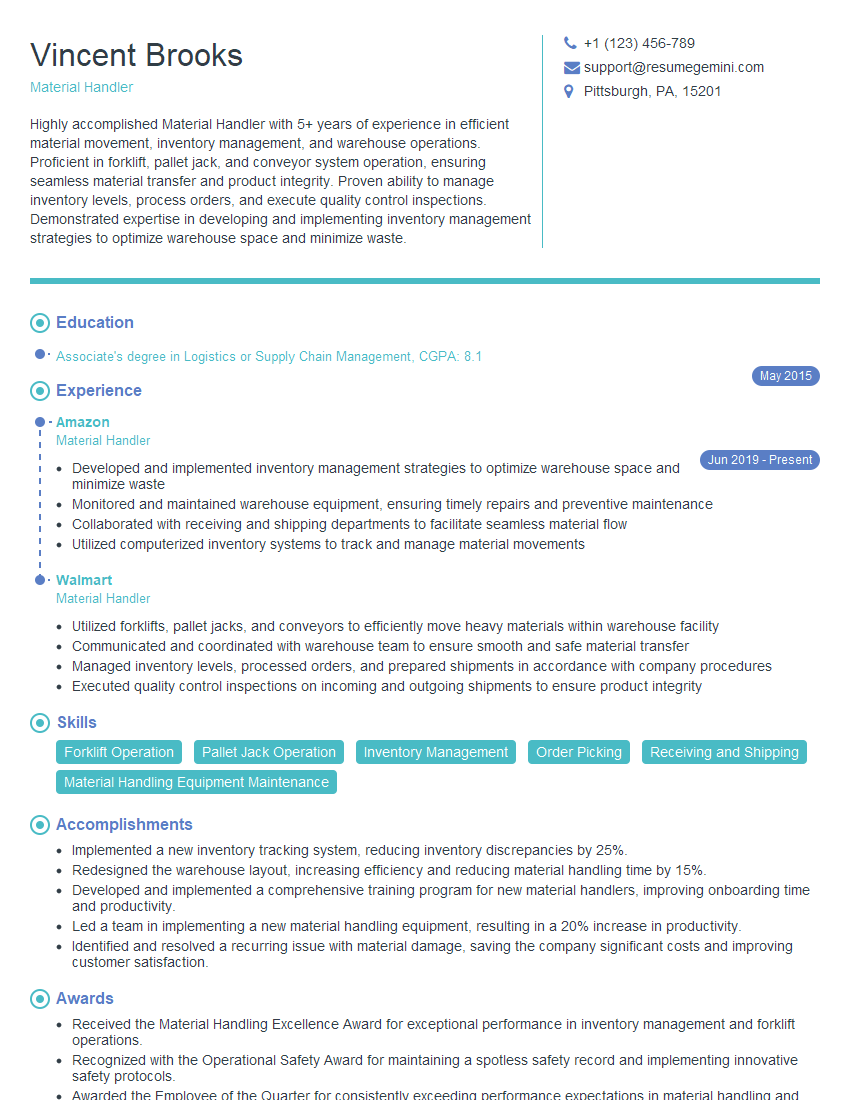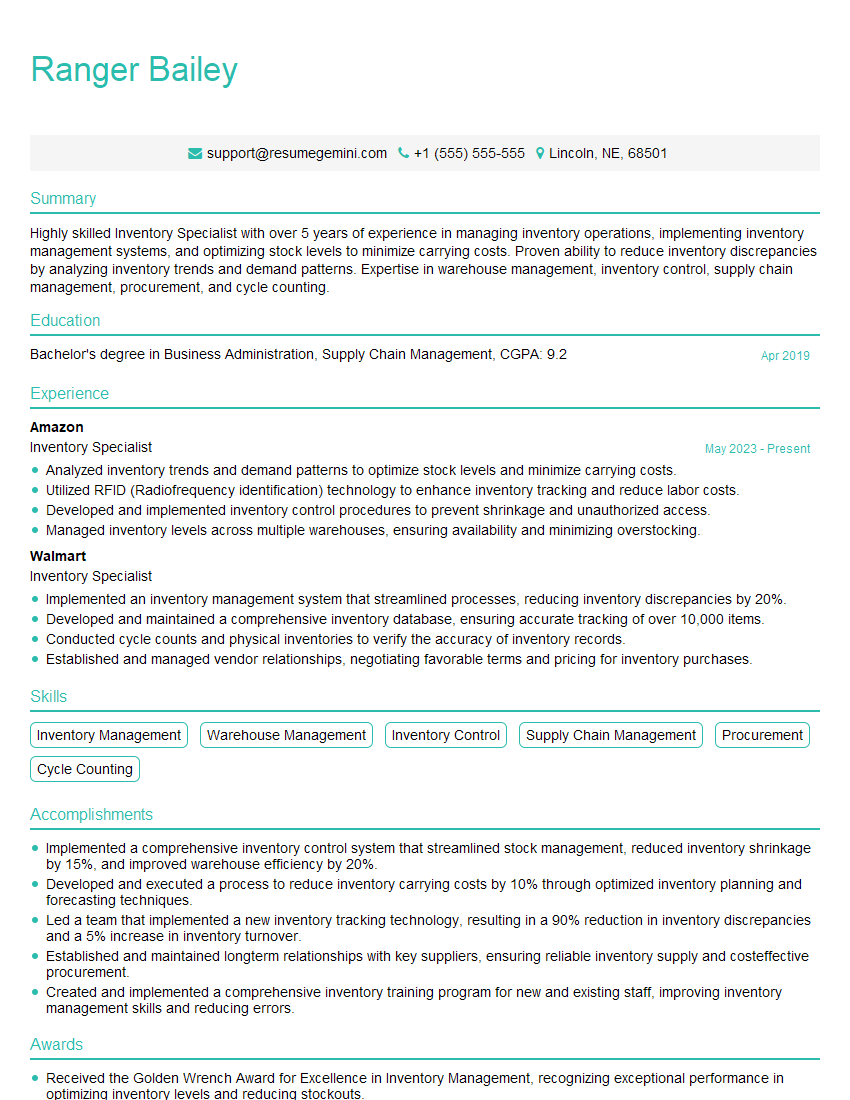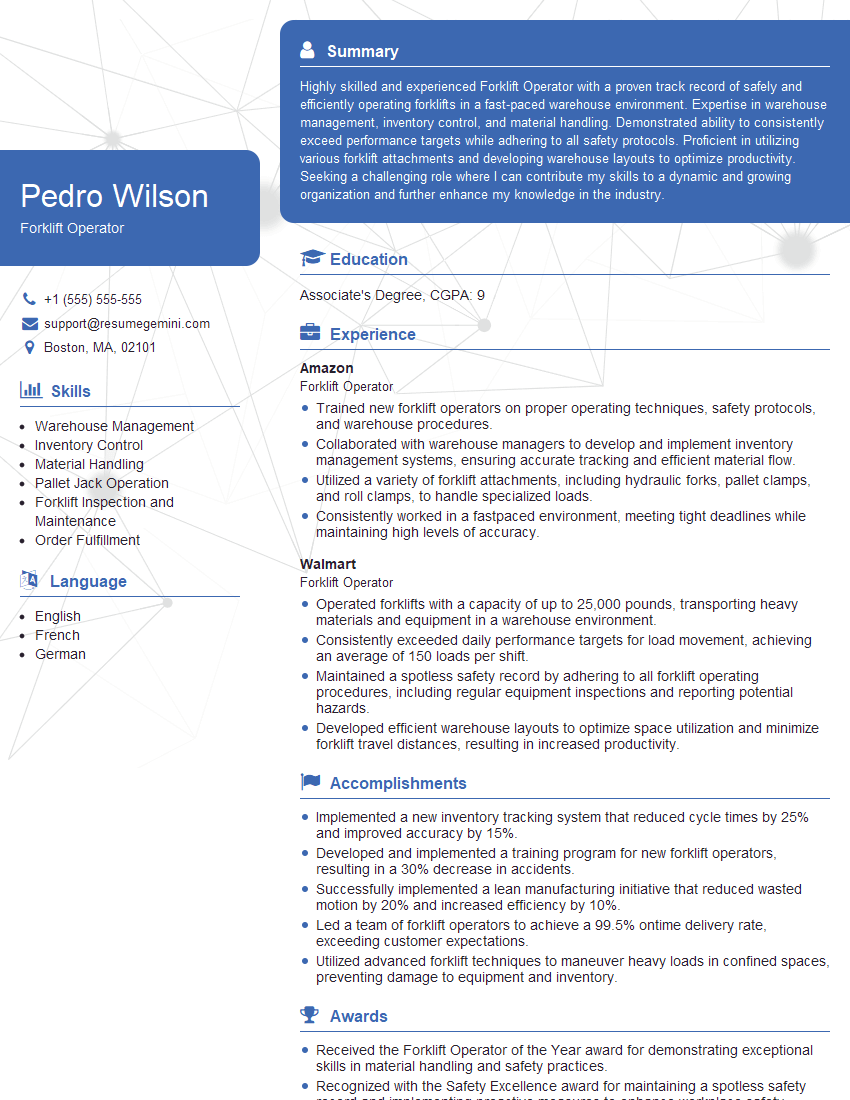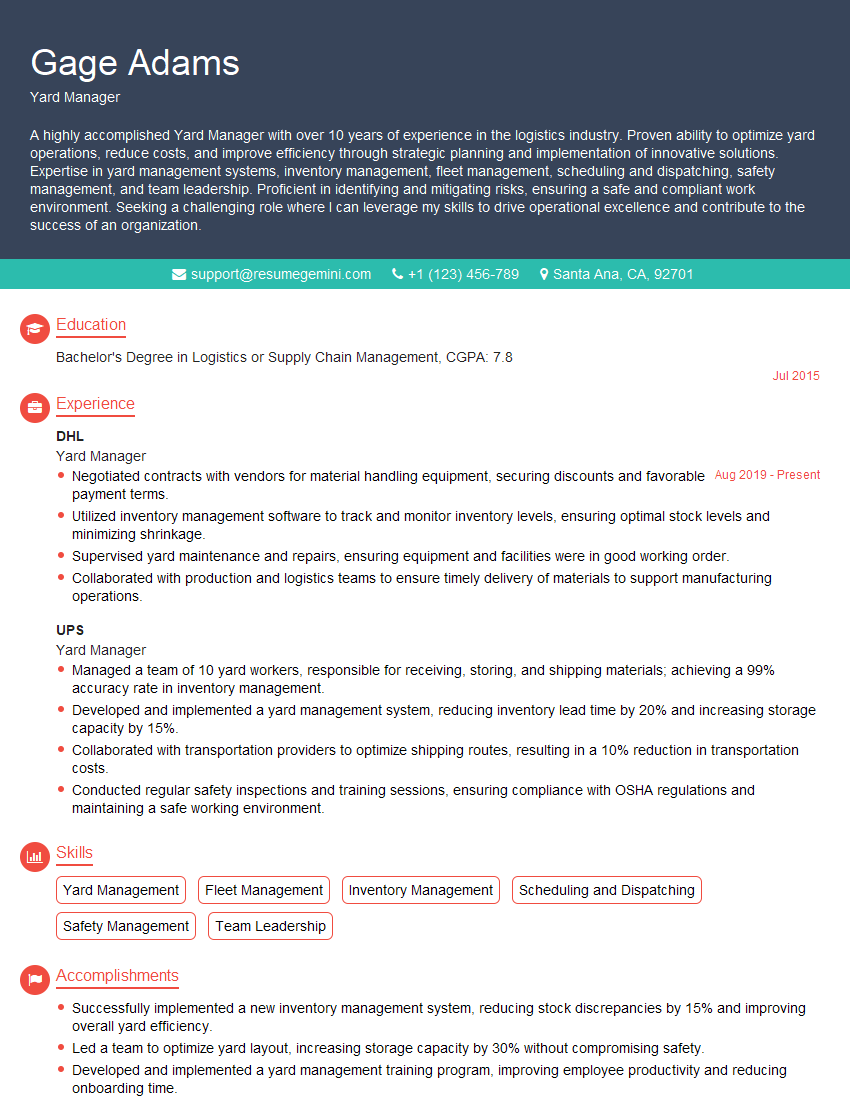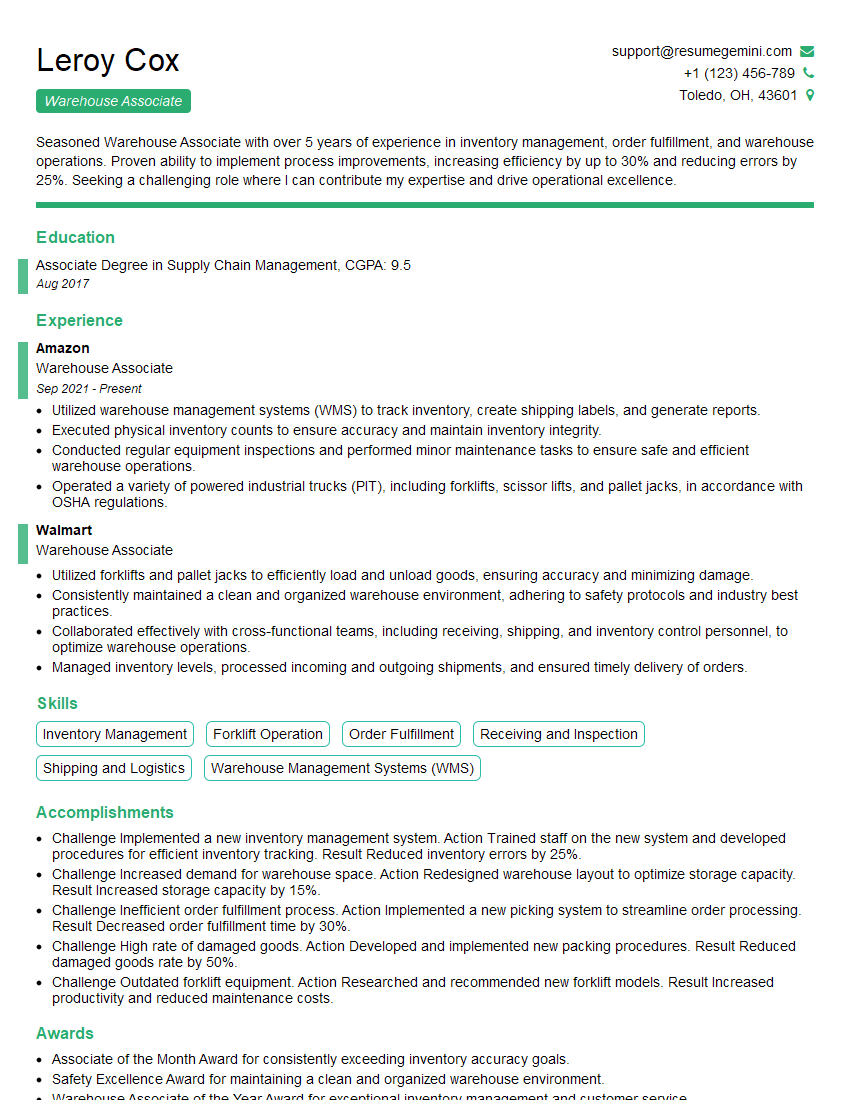Interviews are opportunities to demonstrate your expertise, and this guide is here to help you shine. Explore the essential Material Handling and Stockpiling interview questions that employers frequently ask, paired with strategies for crafting responses that set you apart from the competition.
Questions Asked in Material Handling and Stockpiling Interview
Q 1. Describe your experience with various material handling equipment.
My experience with material handling equipment spans a wide range, encompassing both conventional and automated systems. I’m proficient in operating forklifts (both sit-down and stand-up), reach trucks, order pickers, conveyor systems, and automated guided vehicles (AGVs). I’ve also worked extensively with palletizers, stackers, and various types of cranes, including overhead cranes and jib cranes. For example, in my previous role at Acme Distribution, I was responsible for optimizing the use of our reach trucks to improve the efficiency of our high-bay warehouse. This involved analyzing picking routes, implementing a new slotting strategy, and providing training to operators on best practices. My experience extends to the maintenance and troubleshooting of this equipment; I can identify common malfunctions and perform basic repairs, ensuring minimal downtime. I understand the importance of regular preventative maintenance to keep these systems running smoothly and safely.
Q 2. Explain different stockpiling methods and their suitability for various materials.
Stockpiling methods vary depending on the material’s properties and intended use. For example, bulk materials like sand or gravel are often stockpiled using methods that maximize space and minimize handling. This often involves creating long, conical piles using bulldozers or conveyor systems. These piles need to be carefully managed to avoid instability and potential landslides. More delicate materials, such as bagged goods or manufactured components, require different approaches. These might be stockpiled on pallets, using a combination of racking systems and potentially specialized equipment to create stable stacks. The choice of method also depends on the frequency of access: materials that are frequently needed might be stored in easily accessible locations, whereas less frequently accessed materials can be placed further away. In the case of perishable goods, controlled-environment stockpiling may be necessary with considerations for temperature and humidity. Ultimately, the best stockpiling method is always chosen with safety and efficiency in mind, considering both the physical properties of the material and the operational requirements.
Q 3. How do you ensure efficient inventory management in a warehouse environment?
Efficient inventory management is crucial for any warehouse. I leverage a multi-pronged approach involving accurate cycle counting, robust inventory tracking systems, and effective warehouse layout. Cycle counting involves regularly checking a small portion of the inventory rather than conducting a full inventory count. This helps identify discrepancies early. A reliable Warehouse Management System (WMS) is key, providing real-time visibility into inventory levels and locations. For instance, using a barcode scanning system for accurate stock receiving, put-away, and picking prevents errors common in manual systems. This data-driven approach enables precise inventory forecasting and minimizes stockouts and overstocking. Efficient put-away procedures and clear labeling systems prevent misplaced items and improve picking efficiency. I also work closely with teams to implement regular audits to identify and address any discrepancies. Finally, using a first-in, first-out (FIFO) strategy helps prevent product expiration or obsolescence.
Q 4. What safety procedures do you implement when operating material handling equipment?
Safety is paramount in material handling. Before operating any equipment, a pre-operational check is mandatory, verifying all safety features are functioning correctly (lights, brakes, horns, etc.). This is coupled with wearing appropriate Personal Protective Equipment (PPE), including safety shoes, high-visibility vests, and safety glasses. I always adhere to speed limits within the warehouse and am always mindful of pedestrian traffic, implementing clear traffic management strategies. I enforce strict procedures for load securing to prevent accidents. Regular training is provided to operators on safe operating procedures and emergency response protocols. Furthermore, I ensure that all equipment undergoes regular maintenance and inspections to prevent malfunctions. I also document all safety incidents and near misses, using the information to implement corrective actions and improve overall safety practices. Safety is not just a checklist; it’s a continuous process of improvement and vigilance.
Q 5. How do you optimize warehouse layout for efficient material flow?
Optimizing a warehouse layout focuses on maximizing space utilization and streamlining material flow. This begins with understanding the workflow: identifying the receiving area, storage zones, picking areas, and shipping docks. Frequently accessed items should be strategically located in easily accessible areas to minimize travel time. Fast-moving items are placed closer to shipping docks, while slow-moving items are placed in less accessible areas. Using various storage solutions like racking systems, shelving, and potentially automated storage and retrieval systems (AS/RS) is key to maximizing vertical space. The layout should also consider aisle width, turning radii for equipment, and safety considerations like clear pathways for pedestrians and emergency exits. Simulation software can be helpful in planning and optimizing the layout, allowing for ‘what-if’ scenarios to be tested before implementation. A well-designed layout minimizes travel distances, reduces congestion, and significantly improves operational efficiency. This is particularly important in fast-paced environments.
Q 6. Describe your experience with warehouse management systems (WMS).
My experience with Warehouse Management Systems (WMS) includes both implementation and daily operational use. I’ve worked with several WMS platforms, such as SAP EWM and Manhattan Associates, learning their specific features and functionalities. I’m proficient in configuring WMS parameters to optimize warehouse processes, including receiving, putaway, picking, and shipping. I can also generate reports and analyze data to identify areas for improvement. For example, at my previous company, I worked on implementing a new WMS to replace their outdated system. This included designing workflows, training staff, and integrating the system with our existing ERP. The new system dramatically improved our inventory accuracy, reduced order fulfillment times, and provided valuable data-driven insights into our operations. My skills extend to troubleshooting and resolving issues within the WMS system, ensuring its optimal functionality.
Q 7. How do you handle inventory discrepancies?
Inventory discrepancies are addressed using a systematic approach. The first step is to identify the discrepancy—is it a shortage, surplus, or a misplaced item? Then, I investigate the root cause. This often involves checking receiving documentation, reviewing picking tickets and putaway records within the WMS, and physically verifying the inventory location. I look for patterns; for instance, are discrepancies consistently occurring with a specific product or in a particular area of the warehouse? This can pinpoint issues with the scanning process, incorrect putaway procedures, or problems with the WMS itself. Once the root cause is identified, corrective actions are implemented, which may include retraining staff, adjusting processes, or upgrading equipment. Documentation is critical throughout the process, ensuring transparency and accountability. In the case of significant discrepancies, a full inventory count may be necessary to reconcile the difference and restore accuracy. Regularly scheduled cycle counting and adherence to best practices significantly reduce the occurrence of these discrepancies in the long term.
Q 8. Explain your approach to managing stockpiles in different weather conditions.
Managing stockpiles in various weather conditions requires a proactive and multi-faceted approach. The key is to anticipate potential problems and implement preventative measures. For example, in snowy or icy conditions, we need to ensure that access roads and stockpile areas are properly cleared and treated to prevent accidents and material damage. This might involve using snow plows, de-icers, or even specialized heavy equipment designed for winter operations.
For rainy conditions, we’d implement measures to prevent erosion and water damage. This can include using tarps to cover vulnerable materials, creating drainage channels around stockpiles, or even constructing temporary shelters. In hot and sunny conditions, we might focus on preventing material degradation through sun exposure. This may involve using reflective covers or relocating the stockpile to a shaded area. Regular monitoring, using weather forecasts and visual inspections, is essential for adapting to changing conditions and ensuring stockpile integrity. Documentation of these conditions and implemented measures is crucial for record keeping and future planning.
For instance, during a particularly heavy snowstorm, I successfully directed the team to use a combination of snow removal equipment and strategically placed windbreaks to protect a large stockpile of construction aggregates, preventing significant material loss and downtime. This proactive approach minimized disruption to operations and saved the company considerable expense.
Q 9. What metrics do you use to measure the efficiency of material handling operations?
Measuring the efficiency of material handling operations relies on a combination of key performance indicators (KPIs). These metrics provide insights into various aspects of the process, allowing for continuous improvement. Some critical metrics include:
- Throughput: This measures the volume of materials handled within a specific time frame (e.g., tons moved per hour).
- Order fulfillment rate: The percentage of orders picked, packed, and shipped accurately and on time.
- Inventory turnover rate: Indicates how quickly inventory is sold or used. A higher turnover rate generally suggests efficient inventory management.
- Storage utilization: The percentage of available storage space being used effectively.
- Labor productivity: Measures the output per labor hour, providing insights into workforce efficiency.
- Damage rates: The percentage of damaged goods during handling, highlighting areas needing improvement in safety and process.
- On-time delivery rate: The percentage of orders delivered on or before the scheduled date.
By tracking these metrics, we can pinpoint bottlenecks and areas for optimization. For example, a low throughput rate might suggest the need for more efficient equipment or improved warehouse layout. Regular reporting and analysis of these KPIs are vital for making data-driven decisions to improve material handling efficiency.
Q 10. How do you prioritize tasks in a fast-paced warehouse environment?
Prioritizing tasks in a fast-paced warehouse environment necessitates a structured approach that combines urgency, importance, and resource availability. I typically employ a combination of techniques:
- Urgent/Important Matrix (Eisenhower Matrix): Categorizing tasks based on their urgency and importance allows for effective prioritization, focusing on critical, time-sensitive tasks first.
- Order fulfillment deadlines: Orders with the closest deadlines take precedence, ensuring timely customer service.
- Inventory levels: Prioritizing the replenishment of low-stock items prevents production delays or stockouts.
- Resource allocation: Considering the skills and availability of personnel and equipment when assigning tasks.
- Visual management tools: Using kanban boards or similar systems allows for clear visualization of tasks and their status, streamlining workflow.
For example, if a high-priority customer order is running late, I would re-allocate resources to expedite its completion, even if it meant delaying some lower-priority tasks. Constant communication and flexibility are also key to adapting to unexpected issues and maintaining efficiency in the face of changing priorities.
Q 11. Describe your experience with different types of storage systems (e.g., racking, shelving).
My experience encompasses a wide range of storage systems, each with its own strengths and weaknesses. I’ve worked extensively with:
- Racking systems: Including selective pallet racking, drive-in racking, and push-back racking. These systems are highly efficient for maximizing vertical space and providing easy access to stored items. I’ve found that selective pallet racking offers the greatest versatility, while drive-in and push-back systems are best suited for high-volume storage of similar products.
- Shelving systems: These are ideal for smaller items and offer flexibility in configuration. I’ve utilized various types, from simple static shelving to more advanced mobile shelving systems to optimize space utilization in smaller areas.
- Bulk storage: Such as open floor stacking or silo systems, are suitable for large quantities of homogeneous materials. This requires careful consideration of ground stability and potential risks associated with unstable stacking.
- Automated storage and retrieval systems (AS/RS): I have experience overseeing and managing AS/RS operations, which are highly efficient for large-scale warehouses and high-throughput environments, but require specialized expertise in system maintenance and programming.
The choice of storage system depends heavily on factors such as the type and volume of materials, warehouse space, budget, and operational requirements. I always consider these factors carefully before recommending a specific solution.
Q 12. How do you ensure the accuracy of inventory counts?
Ensuring inventory accuracy is paramount. It’s achieved through a multi-pronged approach combining technology and rigorous procedures:
- Cycle counting: Regularly counting a small subset of inventory items instead of a complete annual count. This minimizes disruption and provides a continuous assessment of inventory accuracy.
- Barcode or RFID scanning: Utilizing barcode or RFID technology for efficient and accurate item tracking and counting during receiving, put-away, picking, and shipping.
- Warehouse Management System (WMS): Implementing a WMS to manage inventory data, track movements, and generate accurate reports. A good WMS is the backbone of inventory control.
- Regular audits: Conducting periodic full or partial inventory counts to verify the accuracy of the WMS and identify discrepancies.
- Staff training: Ensuring all warehouse staff are properly trained in inventory management procedures, including accurate scanning and data entry.
For example, by implementing a cycle counting program and integrating barcode scanning into our daily operations, we reduced inventory discrepancies by 50% within the first year, resulting in significant cost savings and improved order fulfillment.
Q 13. How do you handle damaged or obsolete inventory?
Handling damaged or obsolete inventory requires a structured approach to minimize losses and maintain operational efficiency:
- Identification and segregation: Promptly identifying and segregating damaged or obsolete items to prevent them from being inadvertently shipped or used.
- Root cause analysis: Investigating the reasons for damage or obsolescence to prevent recurrence. This may involve reviewing storage conditions, handling practices, or product lifecycle management.
- Repair or refurbishment: If feasible and cost-effective, repairing or refurbishing damaged items can recover some value.
- Disposal or recycling: Safely disposing of damaged or obsolete inventory in accordance with environmental regulations. This may involve recycling or donating usable items to charities.
- Write-off procedures: Following established procedures for writing off the value of obsolete or unsalvageable items.
For instance, we recently implemented a program to identify and refurbish slightly damaged products, reducing waste and adding back several thousand dollars to our bottom line.
Q 14. What are your strategies for preventing warehouse accidents?
Preventing warehouse accidents requires a comprehensive safety program encompassing various measures:
- Proper training and education: Ensuring all employees receive thorough training on safe operating procedures, including equipment operation, forklift safety, and hazard awareness.
- Regular safety inspections: Conducting routine inspections of the warehouse to identify and rectify potential hazards such as damaged flooring, inadequate lighting, or blocked walkways.
- Implementing safety protocols: Establishing clear safety protocols for all aspects of warehouse operations, including material handling, storage, and housekeeping. This includes using appropriate personal protective equipment (PPE).
- Emergency preparedness: Developing and regularly practicing emergency response plans for fire, spills, or other potential incidents.
- Ergonomic design: Designing the warehouse layout and processes to minimize physical strain on employees, using ergonomic equipment and promoting good posture and lifting techniques.
- Clear signage and communication: Using clear and consistent signage and communication to inform employees of safety procedures and potential hazards.
By implementing a robust safety program and promoting a strong safety culture, we have significantly reduced workplace accidents, creating a safer and more productive environment.
Q 15. Explain your experience with lean manufacturing principles in material handling.
Lean manufacturing principles, applied to material handling, focus on eliminating waste and maximizing efficiency. Think of it like streamlining a river – removing obstacles to ensure a smooth, continuous flow of materials. My experience involves implementing various lean tools such as 5S (Sort, Set in Order, Shine, Standardize, Sustain) to organize the warehouse and reduce search time, Kaizen events to identify and eliminate bottlenecks in material flow, and Value Stream Mapping to visualize the entire process and pinpoint areas for improvement. For example, in a previous role, we implemented a Kanban system for managing inventory of critical components, reducing storage space and preventing overstocking. This resulted in a 15% reduction in lead times and a 10% decrease in inventory holding costs. Another successful application involved implementing pull systems instead of push systems for material delivery to assembly lines, drastically reducing unnecessary inventory and improving overall workflow.
Career Expert Tips:
- Ace those interviews! Prepare effectively by reviewing the Top 50 Most Common Interview Questions on ResumeGemini.
- Navigate your job search with confidence! Explore a wide range of Career Tips on ResumeGemini. Learn about common challenges and recommendations to overcome them.
- Craft the perfect resume! Master the Art of Resume Writing with ResumeGemini’s guide. Showcase your unique qualifications and achievements effectively.
- Don’t miss out on holiday savings! Build your dream resume with ResumeGemini’s ATS optimized templates.
Q 16. How do you manage the movement of hazardous materials?
Managing hazardous materials requires stringent adherence to safety regulations and robust procedures. This starts with proper identification and segregation of hazardous materials from the moment they enter the facility. We utilize specialized containers, clearly labeled with hazard symbols and appropriate safety data sheets (SDS). Movement is carefully planned and controlled, often involving dedicated equipment and trained personnel. For example, we might use spill containment pallets during transportation and specialized forklift attachments for handling specific hazardous goods. Detailed tracking of hazardous materials is crucial, and we use dedicated software to monitor their location and movement throughout the facility, ensuring compliance with all regulations and minimizing the risk of accidents. Regular safety audits and employee training are paramount in maintaining a safe working environment.
Q 17. Describe your experience with RFID or barcode scanning systems.
I have extensive experience with both RFID and barcode scanning systems for material tracking and inventory management. Barcodes provide a cost-effective solution for basic tracking, particularly in high-volume applications where precise location information is less critical. RFID, however, offers superior capabilities, particularly in complex environments. It allows for real-time tracking of individual items, even if they’re stacked or obscured. In one project, we replaced a manual inventory system with an RFID-based solution. This resulted in significant improvements in accuracy and efficiency, eliminating manual counting errors and providing real-time visibility of inventory levels. This, in turn, enabled better forecasting, reduced stockouts, and improved overall supply chain responsiveness. The data collected from both systems informs our inventory management strategies and helps optimize warehouse layout and operations.
Q 18. How do you optimize the use of warehouse space?
Optimizing warehouse space is crucial for minimizing costs and maximizing throughput. It involves a multi-faceted approach. Firstly, we conduct a thorough space audit to understand current usage and identify inefficiencies. Then, we apply principles of efficient storage such as implementing high-bay racking for vertical storage, utilizing narrow aisle racking to maximize floor space, and employing slotting optimization techniques to place frequently accessed items in easily accessible locations. We also utilize advanced warehouse management systems (WMS) to dynamically manage inventory placement and optimize picking routes. Furthermore, cross-docking strategies can be implemented to minimize storage time for goods that are merely being transferred between receiving and shipping areas. Regular reviews of space utilization and adjustments to storage strategies are key to maintaining optimal efficiency. For example, implementing a dynamic slotting system led to a 20% reduction in picking time in one warehouse.
Q 19. How do you ensure the timely delivery of goods?
Ensuring timely delivery requires careful planning and execution across the entire supply chain. It begins with accurate demand forecasting and inventory management. Efficient order processing, optimized routing and transportation management, and real-time tracking are crucial. I leverage advanced transportation management systems (TMS) to plan routes, schedule deliveries, and monitor shipments in real-time. Communication with carriers and customers is maintained throughout the process, allowing us to proactively address any potential delays. Furthermore, the use of dashboards and reporting tools allows for real-time monitoring of key performance indicators (KPIs) such as on-time delivery rates, which allows for immediate corrective actions where necessary. Building strong relationships with reliable transportation providers is also a critical factor in ensuring consistent on-time delivery.
Q 20. What are your strategies for reducing material handling costs?
Reducing material handling costs involves a combination of strategies, focusing on efficiency and automation where appropriate. Improving warehouse layout and implementing efficient storage systems, as previously discussed, directly impacts costs. Investing in automation, such as automated guided vehicles (AGVs) or conveyor systems, can significantly improve efficiency and reduce labor costs in high-volume settings. Optimizing picking routes and utilizing voice-directed picking systems can significantly speed up order fulfillment. Negotiating better rates with carriers and consolidating shipments also helps to reduce transportation costs. Implementing lean methodologies, as described earlier, is also fundamental in reducing waste and improving overall efficiency, directly translating to lower costs. Data analytics plays a vital role in identifying areas for improvement and quantifying the impact of implemented changes.
Q 21. Explain your understanding of different types of conveyor systems.
Conveyor systems are a cornerstone of efficient material handling. Different types cater to specific needs and material characteristics.
- Roller conveyors: Simple, gravity-fed systems suitable for lighter items. They are cost-effective but require some manual handling.
- Belt conveyors: Power-driven systems that can handle heavier items and longer distances. They are highly versatile and can be configured for various applications.
- Chain conveyors: Used for heavier items and can handle a wider range of materials. They are robust but more complex to maintain.
- Screw conveyors: Move bulk materials, often in a horizontal or inclined direction. Ideal for powders and granular materials.
- Overhead conveyors: Space-saving systems used to move items above the floor level, ideal for high-density warehousing.
Q 22. How do you manage peak seasons in a warehouse setting?
Managing peak seasons in a warehouse requires proactive planning and flexible execution. Think of it like preparing for a marathon, not a sprint. We start by forecasting demand well in advance, analyzing historical data and incorporating any known promotional events or seasonal trends. This informs our staffing needs; we might utilize temporary staff, overtime pay, or even cross-train existing employees to handle the increased workload.
Next, we optimize our warehouse operations. This could involve adjusting our picking strategies (perhaps shifting from zone picking to batch picking for higher volume), optimizing storage locations for frequently demanded items, and ensuring all equipment is well-maintained and functioning efficiently. We also focus on streamlining processes to reduce bottlenecks – think of identifying and eliminating any unnecessary steps in order fulfillment.
Finally, we implement robust communication protocols. Keeping all staff informed about expected volumes, changes in procedures, and any potential challenges ensures everyone is on the same page and can respond effectively to the increased pressure. Regular check-ins and clear communication channels are crucial during this period. For example, in my previous role, we successfully navigated a 40% increase in orders during the holiday season by implementing these strategies, resulting in on-time delivery rates exceeding 98%.
Q 23. Describe your experience with order picking and fulfillment processes.
My experience with order picking and fulfillment encompasses a wide range of methodologies, from manual picking to highly automated systems. I’ve worked with various technologies including Warehouse Management Systems (WMS) and Radio Frequency (RF) scanners, which significantly enhance picking accuracy and speed. I’m proficient in various picking methods – zone picking, batch picking, wave picking – each suited to different order profiles and warehouse layouts. For instance, zone picking works best when you have a large warehouse and different teams are responsible for different sections.
My experience extends to order consolidation, packing, and shipping, ensuring accurate order fulfillment from receiving to dispatch. I’m adept at optimizing picking routes and implementing efficient packing strategies to minimize wasted space and shipping costs. In one project, I implemented a new wave picking system which resulted in a 15% reduction in order fulfillment time, significantly improving customer satisfaction.
Furthermore, I’m experienced in integrating order management systems with transportation management systems (TMS) to ensure seamless tracking and delivery updates for our customers. This integration provides real-time visibility into the entire fulfillment process, aiding in proactive problem-solving and ensuring timely delivery.
Q 24. How do you ensure compliance with relevant safety regulations?
Safety is paramount in any warehouse environment. My approach to compliance starts with a thorough understanding of all relevant OSHA (or equivalent) regulations, including those pertaining to material handling equipment operation, personal protective equipment (PPE) usage, and workplace hazard identification and control. I establish and maintain comprehensive safety programs, including regular safety training for all staff, encompassing both theoretical knowledge and practical application.
This includes conducting regular safety inspections of the warehouse, identifying and mitigating potential hazards such as obstructions, spills, and faulty equipment. We use a system of regular audits and incident reporting to continuously improve safety procedures and address any potential concerns promptly. We also ensure appropriate PPE is readily available and utilized, and conduct regular training sessions on its proper use. For example, we would provide specific safety training on forklift operation, emphasizing safe operating procedures and load-handling techniques.
Furthermore, I emphasize a strong safety culture within the team, encouraging proactive reporting of near-miss incidents and fostering a culture of shared responsibility for workplace safety. This is key to minimizing accidents and creating a safe and productive work environment. A documented safety program, regularly reviewed and updated, is crucial for demonstrating compliance and ensuring continuous improvement.
Q 25. Explain your experience with different types of palletizing techniques.
My experience with palletizing techniques includes both manual and automated methods. Manual palletizing involves strategically placing items onto pallets to maximize space and stability, considering factors like weight distribution and product fragility. This requires careful planning and execution to prevent pallet instability and damage to goods during transportation.
Automated palletizing, on the other hand, utilizes robotic systems or automated guided vehicles (AGVs) to increase speed and efficiency, particularly beneficial for high-volume operations. This includes experience with different types of robotic palletizers, from simple layer palletizers to complex ones that can handle a wider range of product shapes and sizes. I understand the importance of selecting the right palletizing system based on factors such as throughput, product characteristics, and available budget.
I also possess expertise in optimizing pallet patterns to maximize space utilization and minimize waste. This might involve using different pallet configurations depending on product dimensions and weight. For instance, interleaving fragile items with more robust ones can prevent damage during stacking. In a previous role, I implemented a new automated palletizing system which reduced labor costs by 20% and increased throughput by 30%.
Q 26. How do you handle returns and damaged goods?
Handling returns and damaged goods requires a systematic approach to minimize losses and ensure efficient processing. We establish clear procedures for receiving and inspecting returned goods, documenting the reason for return and the condition of the product. This information is crucial for identifying potential product quality issues or process improvements.
Damaged goods are handled separately, with procedures in place for safely disposing of items that cannot be salvaged and for repairing or refurbishing those that can be. Depending on the nature of the damage and the product value, we might opt for repair, refurbishment, or liquidation. Proper documentation of the disposal or salvage process is essential for traceability and inventory accuracy.
We also use a robust system for tracking returned and damaged goods, integrating it with our inventory management system to ensure accurate inventory counts and prevent discrepancies. The data generated through this process helps us identify trends and implement preventive measures to reduce future returns and damages. For example, a higher-than-average return rate for a specific product might indicate a need for improved packaging or a clearer product description.
Q 27. Describe your experience with different warehouse layout strategies (e.g., U-shaped, I-shaped).
Warehouse layout significantly impacts efficiency and operational costs. I’ve worked with various layouts, including U-shaped, I-shaped, and L-shaped designs, each suited to different operational needs and product flows. The choice depends on factors such as product volume, order picking methods, and space constraints. For example, a U-shaped layout is ideal for continuous flow processes and can reduce travel distances between workstations.
U-shaped layouts are excellent for assembly or production lines, optimizing workflow and minimizing material movement. I-shaped layouts are simpler and suitable for smaller warehouses or operations with linear product flows. L-shaped layouts combine elements of both, offering flexibility. My experience involves optimizing these layouts based on specific needs, such as integrating fast-moving items closer to shipping docks, and using slotting optimization techniques to place products in locations that minimize travel time during picking.
Beyond these basic shapes, I also understand the importance of considering factors like aisle width, racking systems, and the location of receiving and shipping docks when designing a layout. In a previous role, I redesigned the warehouse layout, shifting from an inefficient I-shape to a U-shape, resulting in a 25% reduction in order fulfillment time and a 10% improvement in space utilization.
Q 28. How do you integrate material handling with overall supply chain management?
Material handling is intrinsically linked to overall supply chain management; it’s not a standalone function but an integral part of the entire process. Efficient material handling directly impacts inventory management, order fulfillment speed, and overall supply chain cost. It’s like the circulatory system of the supply chain; smooth and efficient material flow keeps everything running smoothly.
My approach involves integrating material handling strategies with demand forecasting, inventory planning, and transportation management. This includes selecting the right equipment and technology to support the specific needs of the supply chain, considering factors like order volume, product characteristics, and warehouse layout. For instance, an automated guided vehicle system (AGV) might be appropriate for large warehouses with high throughput, while manual pallet jacks might be sufficient for smaller operations.
Real-time tracking and visibility are also crucial. Integrating material handling systems with warehouse management systems (WMS) and transportation management systems (TMS) provides complete visibility into the movement of goods, enabling proactive problem-solving and optimized resource allocation. This allows for better forecasting, improved inventory accuracy, and reduced lead times. Effective integration, coupled with performance monitoring and continuous improvement initiatives, ensures that material handling activities support the overall supply chain objectives and enhance its competitiveness.
Key Topics to Learn for Your Material Handling and Stockpiling Interview
- Warehouse Layout and Design: Understanding efficient warehouse flow, storage strategies (FIFO, LIFO), and the impact of space optimization on productivity.
- Material Handling Equipment: Familiarity with various equipment types (forklifts, conveyors, automated guided vehicles (AGVs)), their operation, maintenance, and safety protocols. Practical application: Discuss scenarios requiring specific equipment choices based on material characteristics and warehouse layout.
- Inventory Management Systems: Knowledge of inventory control methods (barcode scanning, RFID), software applications (WMS, ERP), and their role in optimizing stock levels and minimizing waste. Problem-solving approach: Describe how you would troubleshoot discrepancies in inventory counts or address stock-outs.
- Safety Procedures and Regulations: Understanding OSHA (or relevant regional) regulations related to material handling, including safe operating procedures for equipment, personal protective equipment (PPE), and hazard identification/mitigation. Practical application: Describe your experience implementing or enforcing safety procedures in a warehouse environment.
- Supply Chain Optimization: Understanding the role of material handling within the broader supply chain, including inbound and outbound logistics, and strategies for improving efficiency and reducing costs. Theoretical concept: Explain the relationship between effective material handling and overall supply chain performance.
- Lean Manufacturing Principles: Applying lean principles (5S, Kaizen) to material handling processes to eliminate waste and improve efficiency. Problem-solving approach: Describe how you would identify and eliminate waste in a material handling process.
- Automation and Robotics in Material Handling: Understanding the integration of automated systems and robotics in modern warehouses and their impact on efficiency and productivity. Theoretical concept: Discuss the advantages and disadvantages of various automation technologies.
Next Steps
Mastering material handling and stockpiling principles is crucial for career advancement in logistics, warehousing, and supply chain management. These skills are highly sought after, opening doors to rewarding and well-compensated positions. To maximize your job prospects, it’s essential to have an ATS-friendly resume that highlights your expertise. ResumeGemini is a trusted resource that can help you create a professional and impactful resume, ensuring your skills and experience are presented effectively to potential employers. We provide examples of resumes tailored to Material Handling and Stockpiling to help you get started.
Explore more articles
Users Rating of Our Blogs
Share Your Experience
We value your feedback! Please rate our content and share your thoughts (optional).
What Readers Say About Our Blog
This was kind of a unique content I found around the specialized skills. Very helpful questions and good detailed answers.
Very Helpful blog, thank you Interviewgemini team.

